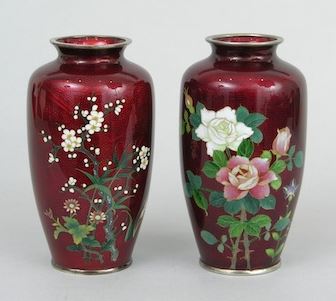Identification and Price guides for Antiques & Collectibles


COLLECTIBLE AND ANTIQUE CLOISONNE:
A Guide to Appreciating and Collecting This Beautiful Art Form
Join the most updated and complete collectibles research online - Learn more...
 Cloisonné is an ancient technique of decorating metalwork with enamels. The art form originated in ancient Persia and was later developed in China, Japan, and other parts of the world. Cloisonné pieces are known for their intricate designs, vibrant colors, and exquisite craftsmanship. Collectors and enthusiasts alike appreciate cloisonné for its historical significance, aesthetic beauty, and cultural value. In this guide, we will explore the history, techniques, and types of cloisonné, as well as provide tips on collecting and caring for these precious works of art.
Cloisonné is an ancient technique of decorating metalwork with enamels. The art form originated in ancient Persia and was later developed in China, Japan, and other parts of the world. Cloisonné pieces are known for their intricate designs, vibrant colors, and exquisite craftsmanship. Collectors and enthusiasts alike appreciate cloisonné for its historical significance, aesthetic beauty, and cultural value. In this guide, we will explore the history, techniques, and types of cloisonné, as well as provide tips on collecting and caring for these precious works of art.
History of Cloisonné
Cloisonné has a long and fascinating history that spans over 1,500 years. The technique was first developed in ancient Persia and was later adopted by the Byzantine Empire. It wasn't until the 14th century that cloisonné was introduced to China, where it flourished and became an integral part of Chinese art and culture. Cloisonné was also practiced in Japan, where it was known as shippo, and in Europe, where it was used to decorate religious objects and jewelry.
Techniques of Cloisonné
Cloisonné is a labor-intensive process that requires skilled artisans and specialized tools. The process involves creating a metal base, usually made of copper or bronze, and soldering metal wires onto the surface to create compartments, or cloisons. The cloisons are then filled with colored enamels, which are made by grinding glass into a fine powder and mixing it with metal oxides to create the desired color. The piece is then fired in a kiln at high temperatures to fuse the enamel to the metal surface. This process is repeated several times to achieve the desired color and texture.
Types of Cloisonné
There are several types of cloisonné, each with its own unique characteristics and history. Some of the most popular types include:
- Chinese cloisonné: Chinese cloisonné is perhaps the most well-known type of cloisonné. It is characterized by its vibrant colors, intricate designs, and use of gold or silver wire to create the cloisons. Chinese cloisonné dates back to the Ming Dynasty (1368-1644) and was used to decorate everything from vases and bowls to furniture and jewelry.
- Japanese cloisonné: Japanese cloisonné, or shippo, is known for its delicate and intricate designs. It was introduced to Japan in the 16th century and became popular during the Meiji period (1868-1912), when Japanese artisans began to experiment with new techniques and materials.
- European cloisonné: European cloisonné is typically found on religious objects and jewelry. It was popular in the Middle Ages and Renaissance and was often used to decorate chalices, reliquaries, and crosses. European cloisonné is characterized by its use of gold or silver wire and its intricate designs.
Collecting Cloisonné
Cloisonné is a popular collectible item among antique enthusiasts and art collectors. When collecting cloisonné, it is important to consider the following factors:
- Condition: Cloisonné pieces can be fragile and are prone to damage. Look for pieces that are in good condition with minimal damage to the enamel or metalwork.
- Authenticity: As with any collectible item, it is important to verify the authenticity of the piece. Look for markings or signatures that can help identify the artist or workshop that created the piece. Research the history and provenance of the piece to ensure that it is genuine.
- Quality: Cloisonné pieces vary in quality, with some pieces being more intricate and finely crafted than others. Look for pieces that display exceptional craftsmanship and attention to detail.
- Rarity: Some cloisonné pieces are rarer and more valuable than others. Look for pieces that are uncommon or have unique features that set them apart from other pieces.
When purchasing cloisonné, it is important to buy from a reputable dealer or auction house. Do your research and compare prices to ensure that you are getting a fair price for the piece. It is also a good idea to get an expert opinion on the piece to verify its authenticity and value.
Caring for Cloisonné
Cloisonné pieces require careful handling and maintenance to preserve their beauty and value. Here are some tips for caring for cloisonné:
- Handle with care: Cloisonné pieces are delicate and can be easily damaged. Handle them with care, and avoid dropping or knocking them against hard surfaces.
- Store properly: Store cloisonné pieces in a dry, cool place away from direct sunlight. Avoid storing them in humid or damp areas, as moisture can damage the enamel and metalwork.
- Clean gently: Clean cloisonné pieces gently with a soft, dry cloth. Avoid using harsh chemicals or abrasive materials, as they can damage the enamel or metalwork.
- Display with care: When displaying cloisonné pieces, use stands or mounts to prevent them from tipping over. Avoid placing them in areas with high traffic or where they can be easily knocked over.
In conclusion, cloisonné is a beautiful and fascinating art form that has captivated collectors and enthusiasts for centuries. Whether you are a seasoned collector or a new enthusiast, collecting and appreciating cloisonné can be a rewarding and enriching experience. By understanding the history, techniques, and types of cloisonné, as well as how to collect and care for these precious works of art, you can deepen your appreciation for this ancient and enduring art form.
Unlock the true value of your collection with our comprehensive research guides from identifying makers' marks to appraising all kinds of antiques and collectibles, including items featured in this article.
Our up-to-date information will give you an accurate understanding of your items' worth. Don't miss out on this valuable resource - visit our research tools today!
In addition to some examples shown below on this page, you can also search our price guide for your own treasures.
Examples of related items from our Price Guides
-
A GROUP OF SEVEN ASIAN CLOISONNE ARTICLESA [more like this]
-
A LARGE ASIAN CLOISONNE ENAMEL MODEL OF A [more like this]
-
TWO CHINESE CLOISONNE DECORATIONSTwo Chinese [more like this]
-
A CHINESE CLOISONNE AND HARDSTONE WALL PANELA [more like this]
-
A GROUP OF SIX CHINESE FLORAL DECORATIONSA [more like this]
-
FOUR ASIAN METAL AND CLOISONNE ENAMEL ARTICLESFour [more like this]
-
A PAIR OF CHINESE BRONZE AND ENAMEL JARDINIERESA [more like this]
-
A CHINESE CLOISONNE ENAMEL JAR NOW AS A LAMPA [more like this]
-
A FRENCH JAPONESQUE CLOISONNE ENAMEL ENCRIERA [more like this]
-
A RUSSIAN 88 STANDARD SILVER-GILT INSET BRATINAA [more like this]
-
A LARGE CHINESE CLOISONNE COVERED JARA large [more like this]
-
A PAIR OF CHINESE CLOISONNE ENAMEL VASESA [more like this]
There are many more auction results available to our members...
Explore more items from our
Antiques & Collectibles Price Guide
A PAIR OF CHINESE CLOISONNE ENAMEL VASESA[more like this]
PR CHINESE BLUE GROUND CLOISONNE ENAMELED[more like this]
PR VINTAGE CHINESE BLUE CLOISONNE ENAMELED[more like this]
A PAIR OF CHINESE CLOISONNé ENAMEL[more like this]
A PAIR OF CHINESE QIANLONG-STYLE CLOISONNé[more like this]
A LARGE PAIR OF CHINESE CLOISONNE ENAMEL[more like this]
A PAIR OF CHINESE CLOISONNé ENAMEL[more like this]
A PAIR OF CHINESE QIANLONG-STYLE CLOISONNé[more like this]
A PAIR OF CHINESE CLOISONNé FLORAL[more like this]
A PAIR OF CHINESE CLOISONNé VASESA[more like this]
This list is limited to only a few results.
Many more items are available to our members through our
Price Guides!






